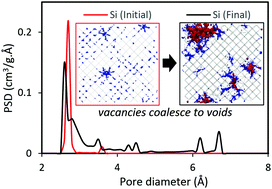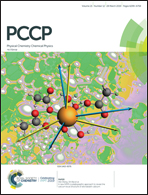Vacancy induced formation of nanoporous silicon, carbon and silicon carbide†
Abstract
Nanoporous semiconductors are used in a range of applications from sensing and gas separation, to photovoltaics, rechargeable batteries, energetic materials and micro electro mechanical systems. In most cases porosity occurs in conjunction with the competing process of amorphisation, creating a complicated material that responds differently to strain and density changes, depending on the composition. In this paper we use simple computational workflow involving Monte Carlo simulation, numerical characterisation and statistical analysis to explore the development of amorphous and nanoporous carbon, silicon and silicon carbide. We show that amorphous regions in Si and SiC form in advance of nanopores, and are essential in stabilising the nanopores once developed. Carbon prefers a porous structure at lower strains than amorphisation and exhibits a bimodal change in the structure which correlates with the change in C–C bond angles from tetrahedral sp3-like bonds to hexagonal sp2-like bonds as the strain increases. These results highlight how both of these processes can be analysed simultaneously using reliable interatomic forcefields or density functionals, provided sufficient samples are included to support the statistics.



 Please wait while we load your content...
Please wait while we load your content...